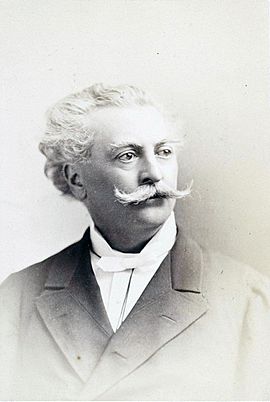Désiré Charnay facts for kids
Quick facts for kids
Désiré Charnay
|
|
|---|---|

Charnay in 1878
|
|
| Born | 2 May 1828 Fleurie, France
|
| Died | 24 October 1915 (aged 87) |
| Scientific career | |
| Fields | archaeology |
Désiré Charnay (born May 2, 1828 – died October 24, 1915) was a French explorer and archaeologist. He is famous for his trips to Mexico and Central America. He was also one of the first people to use photography to record his amazing discoveries.
Contents
Early Life and First Expeditions
Désiré Charnay was born in Fleurie, France. He studied at the Lycée Charlemagne school. In 1850, he moved to New Orleans, Louisiana, in the United States. This city had many French-speaking people. There, he learned about John Lloyd Stephens's books. These books described travels in the Yucatan region.
Charnay became very interested in ancient ruins. From 1857 to 1861, he traveled in Mexico. The French government's education department supported his trip. He explored many places and took photos.
In 1863, he traveled to Madagascar. He visited many parts of the island. He also spent time in the Comoros islands. He was there when the French government met with Queen Jumbe-Souli. Charnay took pictures of this important event.
Returning to Mexico and Other Travels
Charnay went back to Mexico in 1864. He traveled with French troops who were there to support Emperor Maximilian. Later, in 1875, he explored South America. He visited countries like Chile and Argentina. In 1878, he traveled to Java and Australia.
From 1880 to 1883, Charnay returned to Mexico again. He visited many ancient ruined cities. A man named Pierre Lorillard IV from New York City helped pay for this trip. Charnay named a large ruined city near the Guatemalan border "Ville Lorillard" to honor him. However, this name did not become popular. Today, the site is known as Yaxchilan.

In 1886, Charnay traveled to the Yucatan region once more.
Protecting Ancient Sites
Mexico had new laws to protect its ancient sites and treasures. In July 1880, Charnay received a special permission from the government. This allowed him to explore widely and remove artifacts. But, he had to send them to the National Museum first. The museum could keep most of them. The rest could then be sent to France.
However, some members of the Mexican Congress did not agree. They gave strong speeches against the agreement. Important figures like Vicente Riva Palacio and Guillermo Prieto spoke out. Justo Sierra supported the agreement. In the end, the Congress rejected Charnay's agreement.
Even so, Charnay had already started his work. He had found smaller artifacts and kept them from Mexican officials. He only showed the very large items that were too big to hide.
His Writings and Ideas
Désiré Charnay wrote many books about his travels and discoveries. Some of his important books include:
- Le Mexique, souvenirs et impressions de voyage (1863): This was his personal report from his 1857–1861 trip.
- Les Anciennes villes du Nouveau Monde (1885): This book was also translated into English as The Ancient Cities of the New World.
He also translated letters from Hernán Cortés into French. Cortés was a Spanish explorer who came to Mexico.
Charnay had a theory about the ancient people of Mexico. He believed that the Toltec people had moved from other places. He thought that the ancient Mexicans might have come from Asia. He noticed things like Japanese architecture, Chinese decorations, and Cambodian clothing. He thought these looked similar to things he saw in Mexico.
See also
 In Spanish: Désiré Charnay para niños
In Spanish: Désiré Charnay para niños


